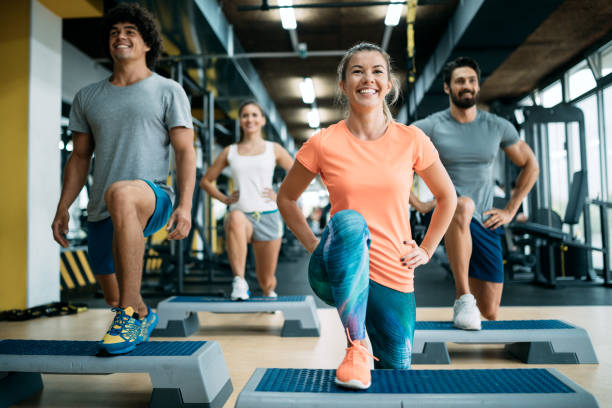Stretching Routine for Office Workers: A Comprehensive Guide to Combating the Harms of Prolonged Sitting
Introduction: The Price of Comfort We Pay at the Office
In our modern world, office work has become an integral part of the lives of millions. While technology and a comfortable office environment provide us with means for productivity, they exact a heavy toll on our physical health. Sitting for long hours in front of a computer screen, with the repetition of the same postures, is a sure recipe for the emergence of chronic pain in the neck, shoulders, and lower back, in addition to joint stiffness and poor blood circulation.
Statistics indicate that the average office worker spends an estimated 80,000 hours sitting during their professional life [1]. This sedentary lifestyle directly contributes to what is known as "Office Syndrome," a set of symptoms that includes the shortening of certain muscles (such as the hip flexors and chest muscles) and the weakening of others (such as the abdominal and gluteal muscles).
The solution does not lie in quitting the job, but in finding a smart balance between productivity and self-care. This is where the stretching routine for office workers comes in. These simple exercises, which can be performed in the workplace without the need for special equipment, are the first line of defense against the harms of prolonged sitting, and they are your key to restoring flexibility, relieving tension, and improving the quality of your professional and personal life.
---
I. Understanding the Problem: How Does Sitting Affect Your Body?
To understand the importance of stretching, we must first recognize the negative effects that prolonged sitting leaves on the body's various systems.
1. Impact on the Musculoskeletal System
Sitting in a fixed position for a long time causes an imbalance in muscle equilibrium:
Shortening of the Hip Flexors: When the knees are bent, these muscles shorten and become tight, pulling the pelvis forward and causing an increase in the arch of the lower back (Lordosis), which is the main cause of chronic lower back pain. Hunchback (Kyphosis) and Rounded Shoulders: Leaning forward toward the screen leads to the stretching and weakening of the upper back muscles, while the chest muscles shorten, resulting in the "rounded shoulders" and "turtle neck" (Forward Head Posture). Neck Pain and Tension Headaches: The forward-tilted head position significantly increases pressure on the neck vertebrae and surrounding muscles, leading to tension and headaches.
2. Impact on Circulation and the Nervous System
Slowed Blood Circulation: Sitting reduces blood flow, especially in the lower extremities, increasing the risk of Deep Vein Thrombosis (DVT) and causing ankle swelling. Nerve Compression: Muscle stiffness around the spine can lead to pressure on nerves, such as the Sciatic Nerve, causing numbness or pain that extends down the legs.
---
II. Benefits of a Regular Stretching Routine for Office Workers
Integrating stretching into your workday is not a luxury; it is a health necessity with tangible benefits:
| Benefit | Detailed Explanation |
|---|---|
| :--- | :--- |
| <strong>Relief of Muscle and Joint Pain</strong> | Stretching works to lengthen short and tight muscles, reducing pressure on joints and vertebral discs, and effectively alleviating neck and back pain. |
| <strong>Improved Posture</strong> | Stretching helps to realign the body and strengthen the muscles responsible for maintaining an upright posture, correcting hunchback and rounded shoulders. |
| <strong>Increased Flexibility and Range of Motion</strong> | Stretching increases the elasticity of the connective tissues around the joints, facilitating movement and reducing the risk of injury during daily activities. |
| <strong>Enhanced Blood Circulation</strong> | Moving muscles and joints stimulates the flow of blood and oxygen throughout the body, reducing feelings of sluggishness and fatigue. |
| <strong>Stress Reduction and Improved Focus</strong> | Stretching acts as a mental break, helping to release muscular tension associated with psychological stress, which promotes relaxation and improves the ability to concentrate. |
---
III. Practical Stretching Routine: Exercises You Can Do at Your Desk
To achieve maximum benefit, the stretching routine should target the areas most affected by sitting: the neck, shoulders, chest, and lower body.
A. Upper Body Stretches (Neck and Shoulders)
These exercises are essential for combating forward head posture and shoulder tension.
#### 1. Side Neck Stretch (H3)
Goal: Side neck muscles (Upper Trapezius). How to Perform: Sit up straight. Gently lower your right ear toward your right shoulder. You can use your right hand gently to increase the stretch by placing it on your head. Duration: Hold for 20-30 seconds on each side. Note: Keep your shoulders relaxed and avoid rounding them forward.
#### 2. Cross-Body Shoulder and Arm Stretch (H3)
Goal: Posterior shoulder muscles. How to Perform: Extend your right arm across your chest. Use your left arm to gently press on the right arm above the elbow, pulling it toward your chest. Duration: Hold for 20 seconds for each arm.
#### 3. Doorway Chest Stretch (H3)
Goal: Chest muscles (which shorten due to leaning forward). How to Perform: Stand in a doorway or corner. Place your forearms on the sides of the frame with your elbows at a 90-degree angle. Step forward slowly until you feel a gentle stretch in your chest. Duration: Hold for 30 seconds.
B. Torso and Lower Back Stretches
These exercises target stiffness in the lower back and pelvis.
#### 1. Seated Torso Twist (H3)
Goal: Lower back and oblique abdominal muscles. How to Perform: Sit on the edge of your seat. Twist your torso to the right, placing your left hand on your right knee and your right hand on the back of the chair. Use your hands to gently deepen the twist. Duration: Hold for 20 seconds on each side.
#### 2. Forward Lower Back Stretch (H3)
Goal: Lower back muscles. How to Perform: Sit up straight. Slowly bend forward, trying to touch the floor with your hands. Let your head hang. Duration: Hold for 30 seconds.
C. Lower Body Stretches (Glutes and Legs)
Sitting is the biggest enemy of this area, and stretching here is crucial for relieving lower back pain.
#### 1. Seated Glute Stretch (Figure 4) (H3)
Goal: Gluteal muscles and the Piriformis muscle, an excellent stretch for relieving pressure on the Sciatic Nerve. How to Perform: Sit up straight. Place your right ankle on your left thigh (to form a figure 4 shape). Keep your back straight and slowly lean forward from the hips (not the back) until you feel a deep stretch in your right glute. Duration: Hold for 30 seconds for each leg.
#### 2. Seated Hamstring Stretch (H3)
Goal: Hamstrings. How to Perform: Sit on the edge of the chair. Extend your right leg in front of you with your heel on the floor. Keep your back straight and lean forward from the hips (not the back) toward your right foot. Duration: Hold for 20 seconds for each leg.
#### 3. Standing Hip Flexor Stretch (H3)
Goal: Hip Flexors. How to Perform: Stand in front of your office chair. Place your right foot on the chair. Gently push your pelvis forward until you feel a stretch in the front of your left thigh. Duration: Hold for 20 seconds for each leg.
---
IV. Practical Tips for Integrating Stretching into Your Workday
The best stretching routine is the one you stick to. Here are some strategies to make it a natural part of your day:
1. The 20-20-20 Rule
This is the golden rule for protecting your eyes and body from screen strain: Every 20 minutes of work, look at something 20 feet (about 6 meters) away for 20 seconds. Use these twenty seconds to perform a quick neck or shoulder stretch.
2. Scheduled Movement Breaks
Don't wait until you feel pain to start stretching. Schedule short, specific breaks:
Short Breaks (5 minutes): Every hour, stand up, walk around a little, and perform 2-3 quick stretches (like neck and shoulder stretches). Medium Breaks (10-15 minutes): Twice a day (mid-morning and mid-afternoon), dedicate time to a comprehensive stretching routine that targets all the main muscle groups mentioned above.
3. Using Technology as a Reminder
Use reminder apps or alarms on your phone or computer to remind you to stand up and move. You can name the alarms after the exercises (e.g., "Glute Stretch") to link the reminder to the action.
4. Supportive Work Environment (Ergonomics)
Stretching cannot compensate for a poor work environment. Ensure that:
Screen: Is at eye level and an arm's length away. Chair: Supports the curve of your lower back, and your feet are flat on the floor or on a footrest.
- Keyboard and Mouse: Are close to your body, and your elbows are at a 90-100 degree angle.
| Common Stretching Mistake | How to Avoid It |
|---|---|
| :--- | :--- |
| <strong>Ballistic Stretching (Bouncing)</strong> | Avoid fast movements or bouncing during stretching. The stretch should be <strong>static and gentle</strong> to avoid muscle tears. |
| <strong>Holding Your Breath</strong> | Breathe deeply and slowly during the stretch. Exhaling helps the muscles relax and deepen the stretch. |
| <strong>Stretching to the Point of Pain</strong> | You should feel a gentle, comfortable pull, not sharp pain. If you feel pain, reduce the intensity of the stretch. |
| <strong>Neglecting Warm-up</strong> | Although office stretching is light, it is always preferable to start with some light joint rotation movements before deep stretching. |
---
V. Conclusion: Invest in Your Health to Increase Your Productivity
Office work does not necessarily have to be synonymous with pain and stiffness. By integrating a thoughtful and regular stretching routine into your day, you are not just treating symptoms, but investing in your long-term health.
Remember that stretching is a conscious practice that requires attention to your body. Start today by applying the mentioned exercises, and make movement breaks a sacred part of your schedule. When you feel flexible and comfortable, you will find that your focus and productivity have significantly improved. Make your office a place for both work and wellness.
---
References
[1] The Ultimate 'Deskercise' Routine: Stretches for the Office - Healthline (URL: https://www.healthline.com/health/deskercise) [2] 10 Best Stretches for Office Workers - Center for Spine and Ortho (URL: https://centerforspineandortho.com/10-best-stretches-for-office-workers/) [3] Desk stretches: Video collection - Mayo Clinic (URL: https://www.mayoclinic.org/healthy-lifestyle/adult-health/in-depth/office-stretches/art-20046041) [4] CCOHS: Office Ergonomics - Stretching - At the Workstation (URL: https://www.ccohs.ca/oshanswers/ergonomics/office/stretching.html) [5] 12 Best Stretches You Should Do After Sitting All Day - Hinge Health (URL: https://www.hingehealth.com/resources/articles/sitting-stretches/)



